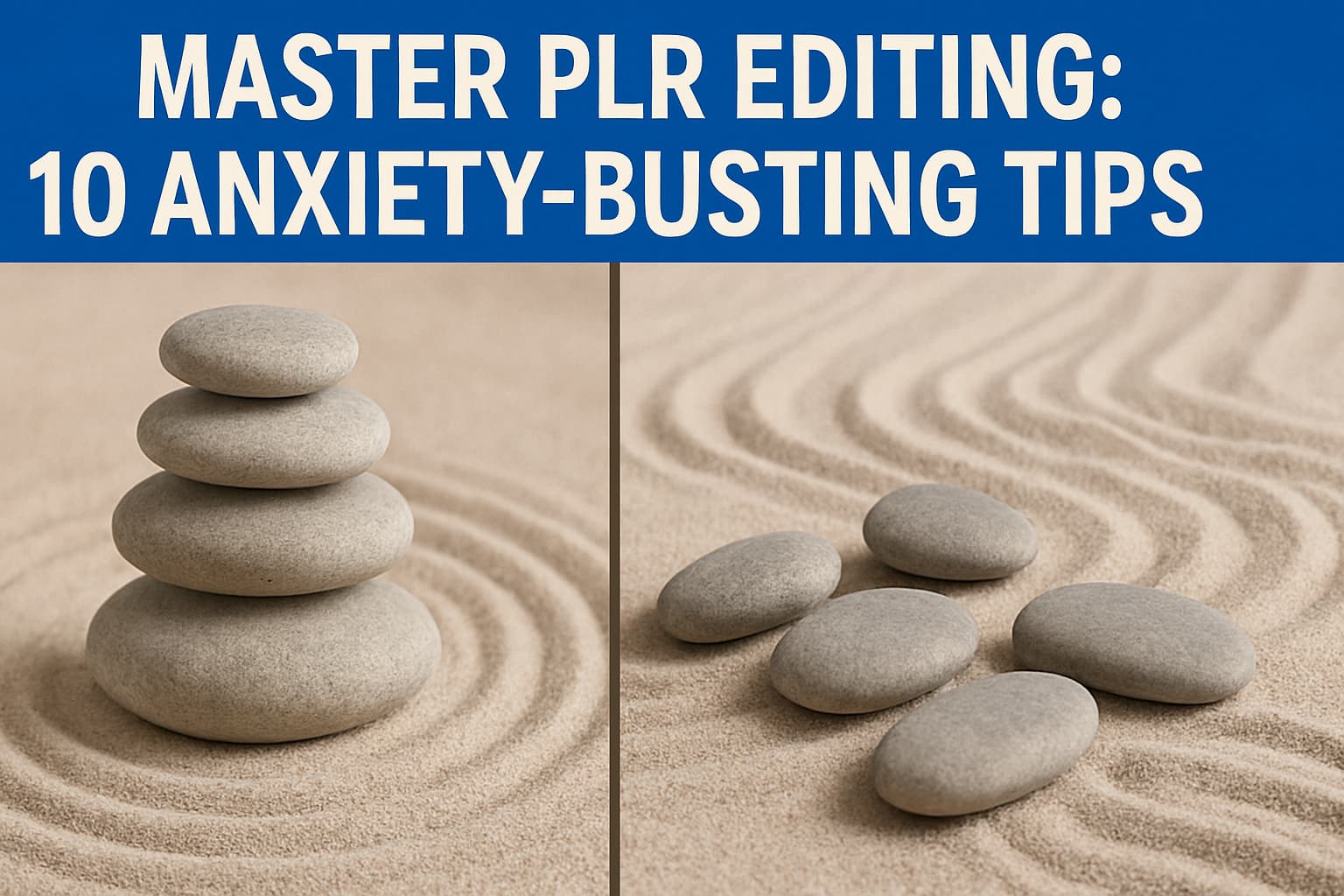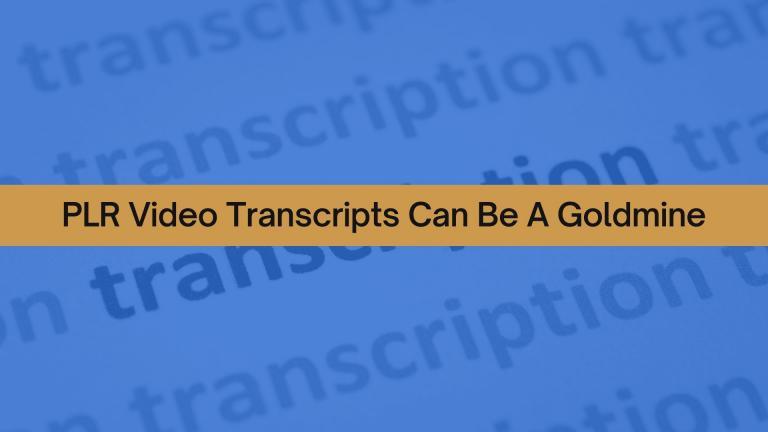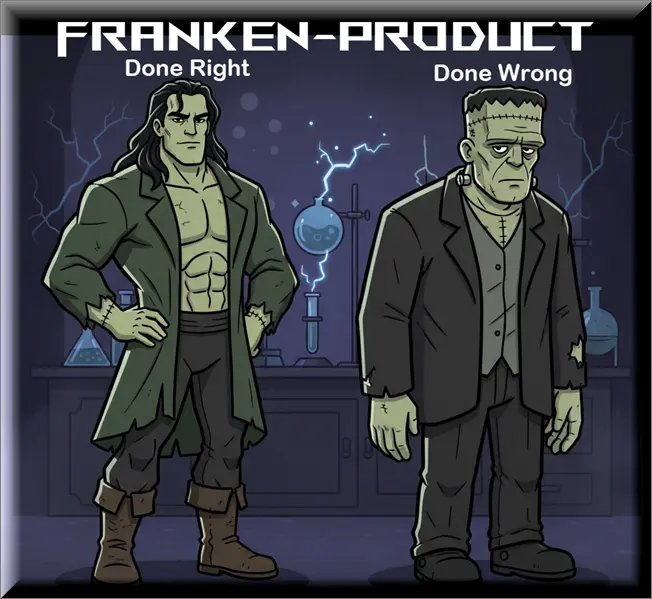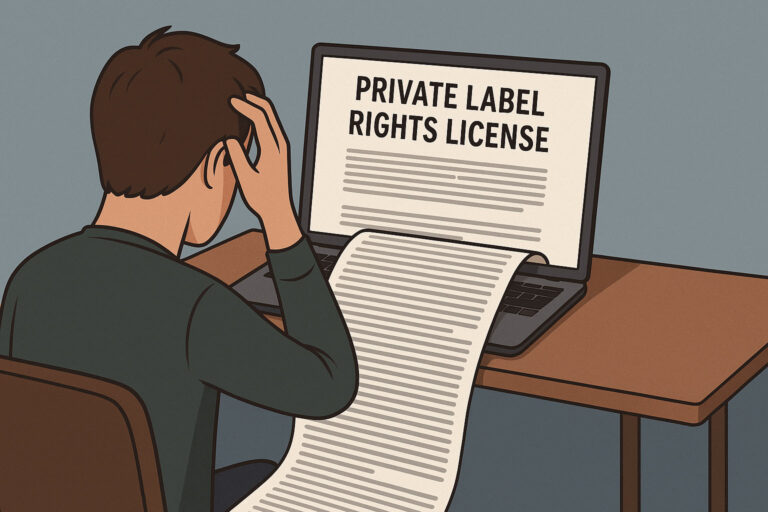Breaking down PLR editing into bite-sized steps makes the process much less intimidating. We’ll want to start by organizing our content into three categories: must-keep material, sections needing work, and complete rewrites. Let’s tackle each chunk with focused 25-minute editing sessions, using simple language swaps and reading aloud to catch awkward phrasing. We’ll maintain consistent formatting through templates, track our changes systematically, and always keep backups of original files. By dividing larger projects into manageable sections and following a structured approach, we’ll transform overwhelming PLR content into polished, professional material. These foundational steps are just the beginning of your PLR mastery journey.

Key Takeaways
- Break large PLR content into smaller, manageable chunks of 5 pages or less to prevent feeling overwhelmed during editing.
- Use focused 25-45 minute editing blocks with breaks to maintain concentration and reduce stress while working.
- Create organized file systems with clear naming conventions and backups to eliminate worry about losing edited content.
- Read content aloud to naturally identify areas needing improvement and build confidence in your editing decisions.
- Track all significant changes in a master document to maintain control and prevent anxiety about forgotten modifications.
Break Content Into Manageable Chunks
Breaking down PLR content into smaller, digestible sections makes editing far more manageable.
We’ve found that tackling an entire PLR package at once can feel overwhelming, but smart content organization changes everything.
Let’s break this down into practical chunking strategies you’ll actually want to use.
Start by dividing your PLR content into three main categories: must-keep sections, needs-work portions, and complete rewrites.
We recommend creating separate documents for each chunk – it’s totally up to you how granular you want to get.
For instance, if you’re working with a 50-page PLR ebook, split it into 5-page segments or natural chapter breaks.
Here’s where the magic happens: each chunk becomes its own mini-project.
We can focus on polishing one section at a time, whether it’s refining the introduction, beefing up the how-to segments, or restructuring those case studies.
Think of it like eating a sandwich – you wouldn’t try to stuff the whole thing in your mouth at once, right?
Create Your PLR Editing Checklist
With a solid editing checklist, PLR content transformation becomes systematic and extensive.
Let’s create a thorough checklist that’ll help us tackle each PLR project with confidence and consistency.
Start by listing your content goals and audience focus at the top of your checklist – this keeps your intended outcome clear throughout the editing process.
We’ll want to include essential steps like reviewing multiple PLR sources for unique angles, running the content through reliable editing tools, and performing thorough plagiarism checks.
Your checklist should also track formatting consistency, voice adjustments, and fact verification.
Here’s what we recommend including: headline optimization, keyword placement verification, introduction enhancement, subheading assessment, flow smoothing, and conclusion strengthening.
Don’t forget to add technical aspects like checking image rights, updating statistics, and verifying links.
We’ve found it’s totally up to you to customize this checklist based on your specific needs – maybe you’ll want to add brand voice guidelines or content length parameters.
Keep your checklist in a digital format that’s easy to update as you discover new editing requirements or preferences.
Start With Simple Language Changes
Once you’ve prepared your editing checklist, simple language adjustments become your first hands-on task.
Let’s start by focusing on language clarity – it’s the foundation of making your PLR content uniquely yours. We’ll replace complex words with simpler alternatives that pack more punch while maintaining the message’s core meaning.
Here’s our proven approach to word simplification: First, we’ll swap out passive phrases like “it was determined that” with active ones like “we found.” Next, we’ll hunt down unnecessarily complex terms – for example, changing “utilize” to “use” and “commence” to “begin.” It’s like giving your content a fresh haircut – trimming away the excess while keeping the style.
Let’s also tackle those lengthy sentences that make readers lose their breath. If you spot a sentence running longer than 25 words, let’s break it down.
For instance, “The implementation of strategic marketing initiatives requires careful consideration of demographic factors and market trends” becomes “We need to plan our marketing carefully. Let’s consider both our audience and market trends.” See how much cleaner that feels?
Read Content Out Loud
Reading your PLR content aloud serves as one of the most effective ways to catch awkward phrasing, run-on sentences, and unnatural language patterns. When we verbalize the words, our brain processes them differently than when we read silently, making it easier to spot areas that need improvement.
Let’s take our voice modulation into account during this process. When we naturally pause or change our tone while reading, it often signals where we need to adjust punctuation or restructure sentences. We’ll notice if we’re running out of breath during a sentence or if certain phrases just don’t flow smoothly from our lips.
Think of this as pronunciation practice too – if we stumble over certain words or phrases, our readers probably will as well.
Here’s a pro tip: record yourself reading the content, then play it back. You’ll be amazed at how many subtle improvements you’ll catch, from repetitive words to clunky shifts.
We can even try reading it in different voices or speeds to guarantee the message remains clear regardless of how it’s consumed. Remember, if it sounds natural when spoken, it’ll read naturally on the page.
Focus On One Section First
Now that we’ve mastered reading our content aloud, let’s narrow our editing scope to make the process more manageable. One of the most effective focus techniques is to break down your PLR content into smaller, digestible sections.
Think of it like eating an elephant – one bite at a time!
When applying section prioritization, we recommend starting with these key segments:
- Introduction – It’s your first impression, so make it count
- Main subheadings – These create your content’s backbone
- Conclusion – Where you tie everything together
- Call-to-action – The money-maker that drives engagement
- Connections – The glue that holds your sections together
Let’s tackle each section individually, giving it our complete attention before moving on. For instance, if you’re working on the introduction, don’t worry about that clunky conclusion just yet – it’s totally up to you which section to polish first.
This approach prevents the overwhelming feeling that often comes with editing an entire document at once. We’ll find that our focus sharpens when we’re not constantly jumping between different parts of the content.
Use Templates For Consistency
Templates serve as your secret weapon for maintaining professional consistency across all PLR content edits.
Let’s look at the key template benefits that’ll transform your editing workflow and save countless hours of decision-making. When we establish consistent formatting, headers, and styling, we’re creating a polished, cohesive brand voice that readers instantly recognize.
We recommend starting with three essential template types: content structure templates, formatting guides, and brand voice documents. Your structure template should outline standard sections like introductions, main points, and calls-to-action.
The formatting guide keeps your headings, fonts, and spacing uniform, while the brand voice document defines your tone and style preferences.
Here’s a pro tip: Create a master checklist within your templates that includes commonly replaced elements like headlines, keywords, and connecting phrases.
You’re totally up to you to customize these templates based on your niche, but maintaining consistency is non-negotiable. By implementing these template systems, we’ll reduce editing time by up to 50% while ensuring every piece maintains the same high-quality standards.
Think of templates as your PLR editing autopilot – they handle the routine stuff while you focus on creative improvements.
Track Your Changes Systematically
Building on our template foundation, systematic change tracking takes your PLR editing to the next level.
Let’s look at how implementing a structured approach with your editing software helps maintain control over your modifications while reducing stress.
When we’re diving into PLR content, it’s essential to document every significant change we make. Modern editing software makes this process seamless, allowing us to track modifications without breaking a sweat.
Here’s what we recommend incorporating into your tracking system:
- Create a master document that logs the date and type of each edit
- Use your editing software’s built-in change tracking features to highlight modifications
- Maintain a separate spreadsheet for larger structural changes
- Save versions with clear naming conventions (v1.0, v1.1, etc.)
- Document your reasoning behind major content shifts
We’ve found that this systematic approach prevents those “wait, what did I change?” moments that can throw us off track.
By maintaining detailed records, we’re able to confidently move forward with our edits while keeping the option to revert changes if needed.
It’s totally up to you how detailed you want to get, but having a system in place is non-negotiable.
Set Realistic Time Blocks
Managing your PLR editing time effectively requires breaking the work into realistic chunks.
Let’s look at how we can divide our editing sessions into manageable blocks that won’t leave us feeling overwhelmed or burned out.
We’ve found that 25-45 minute focused editing blocks work best for most PLR content, allowing us to maintain concentration without hitting mental fatigue.
Using proven time management techniques like the Pomodoro Method, we’ll take short breaks between blocks to recharge – and yes, that includes grabbing your favorite caffeinated beverage!
Here’s how we structure our editing blocks for a typical PLR article:
First block for initial read-through and outlining changes (25 minutes),
second block for major content revisions (45 minutes),
and final block for polishing and proofreading (30 minutes).
These productivity techniques help us stay on track without getting lost in endless editing cycles.
Keep Original File Backup
Now that we’ve organized our editing time effectively, let’s protect our work with smart file management.
Creating a robust backup system isn’t just about data security – it’s about maintaining our peace of mind while editing PLR content.
Let’s look at the essential steps for keeping our original files safe and organized:
- Save the original PLR file with “_ORIGINAL” in the filename before making any changes, storing it in a dedicated “Originals” folder
- Create a new working copy in your “In Progress” folder, using a consistent naming convention that includes the date and version number
- Set up automatic cloud backups for both folders to protect against hardware failures or accidental deletions
- Keep separate folders for different PLR providers to maintain clear file organization
- Export finished versions to a “Completed Projects” folder, maintaining a clear path from original to final product
Following these file organization practices helps us avoid those heart-stopping moments when we can’t find our work.
We’ve all experienced that panic when a file goes missing – but with this system, we’ll always have a safety net.
Review Changes Gradually
A thoughtful editor knows that rushing through PLR modifications can lead to inconsistencies and errors. Let’s look at how we can break down our review strategies into manageable chunks that won’t overwhelm us during the editing process.
| Stage | Action | Time Frame |
|---|---|---|
| Initial | Scan content structure | Day 1 |
| Middle | Edit sections individually | Days 2-3 |
| Final | Polish and refine | Day 4 |
We’ll want to assess progress at each stage before moving forward. Start by reviewing the overall structure and flow, then tackle one section at a time – it’s totally up to you which order works best. Think of it like eating a sandwich: you wouldn’t try to stuff the whole thing in your mouth at once!
When we review gradually, we’re able to catch subtle issues that might slip through during a rushed edit. Take notes as you go along, marking sections that need additional attention. This methodical approach helps us maintain consistency while ensuring we don’t miss important details. Remember, quality PLR editing isn’t a race – it’s about creating content that truly resonates with your audience.
Frequently Asked Questions
How Many PLR Articles Should I Edit in One Day?
Hey there, Captain Go-Getter. Let’s aim for 1 or 2 PLR articles per day to maintain quality and avoid burnout. We recommend starting small and increasing your daily editing goals as you develop stronger productivity tips and efficient workflows.
Can I Sell PLR Content on Freelance Platforms After Editing?
We don’t recommend selling edited PLR content on freelance platforms. It’s against most freelance ethics and PLR licensing terms. Instead, let’s create original content that truly showcases your unique expertise and value proposition.
Now that original content CAN include bits and chunks of relevant PLR content. If you want to feel even better about your (end results) content before selling it (or even publishing it on your own sites) run it through a plagiarism checker like what Grammarly has or by now, there should be several online tools to choose from as well.
Let’s Wrap This Up
We’ve covered some tips to make your PLR editing less overwhelming and more manageable. From breaking content into chunks to systematically tracking changes, these anxiety-busting tips will help streamline your workflow.
Let’s put these techniques into practice – start with one small section, follow your checklist, and build momentum gradually.
Remember, successful PLR editing isn’t about perfection in one go; it’s about making steady, confident improvements through organized steps.







